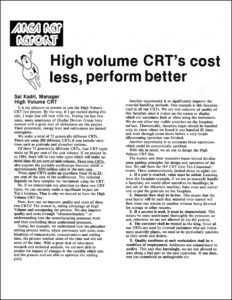Production of Tektronix cathode ray tubes started in 1954 at the Sunset plant. After purchase of the Beaverton campus, a dedicated CRT production facility, Building 46, was constructed in 1960. With continued demand for tubes, Building 48 was brought on line in 1968.
Tek CRTs were produced in batches using carts to transport work in process from station to station. This was initially satisfactory, but as volumes continued to increase, rejects from contamination and faceplate chips or scratches became a costly problem. CRT scrap costs reached painful levels and a project was initiated in the late 1970s to create a consolidated CRT process facility focused on the production of the highest-volume conventional CRTs. The line was to be enclosed in a limited-access clean-room and automated as much as possible. A linear process flow was planned with an emphasis on use of robotics where possible and completing tubes rather than storing parts in process where they might be damaged or contaminated. The new line was located on two floors in Building 48. It occupied the space vacated when the integrated circuit manufacturing group moved to their new processing facility in Building 59.
Projections were made indicating that two CRTs would constitute more than 60% of total tube volume moving forward. One of these was the CRT used in the extremely popular 465 portable scope. In addition to several CRT variations employed in different 465 models, these tubes were also used in Telequipment scopes as well as the 2K and T900 lines. The CRT used in the successor to the 400 series portables, the 2440/2460 line, was the other high-volume tube. Eventually other compatible CRTs were also processed on the line.
Design, construction and de-bug took three years. The most challenging part of the project was the bulb-preparation line which produced an assembly consisting of the faceplate, ceramic funnel and neck glass with deposited phosphor and aluminization. This component would then be mated to an electron gun, produced in another part of the new facility. The bulb/gun assembly would then be pumped, processed and tested. The bulb prep line featured a conveyor for parts in process, resulting in minimal handling. In-line ovens were also employed. Much of the process equipment and automation was developed in-house with the assistance of local vendors.
Yields on the new process line were dramatically improved. Based on scrap reduction savings, the return on investment for the facility was a remarkable two years. Lee Van Nice, project manager for the bulb prep line, noted that in addition to reducing CRT costs, an equally important outcome was a noticeable improvement in cosmetic quality and tube consistency.
The CRT High Volume Line was often showcased to visitors who could observe the operation through windows on the perimeter. Production continued until CRTs were replaced by liquid crystal displays and the line was shut down in the mid-1990s.
The following April 1, 1983 TekWeek article describes the project. Click on the image to view the PDF.
This Tektronix film describes in detail the High-Volume CRT production line on the Beaverton campus for producing CRT's for the 465 Oscilloscope, which sold more than 250,000 during its lifetime, as well as for the 475, 2300 and 2400 series oscilloscopes.

